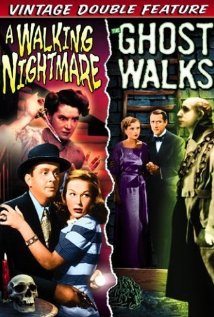
THE GHOST WALKS
US, 1934, 69 minutes, Black and white.
John Miljan, June Collyer, Richard Carle, Johnny Arthur.
Directed by Frank R. Strayer.
This is another of those early 1930s brief supporting features with touches of comedy and touches of horror and scare. The film was directed by Frank R. Strayer, quite prolific during the 1930s with thrillers like this, but at the end of his career in the mid-to-late-1940s, he moved to evangelical religious themes and made for films, including The Pilgrimage Play.
Old dark houses were very popular at this stage and this is a variation. A group of travellers arrive at an isolated mansion, storms preventing anyone leaving. A playwright has brought a producer and his assistant to the mansion to have a reading of his play. When they arrive, a number of sinister things happen, personal clashes between the people of the mansion, and a woman whose husband has been killed acting in a very strange manner. The producer and his rather campy assistant certainly want to get out of the house but are trapped.
Then the playwright explains that what they have experienced is actually the first act of the play. When the demented lady seems to have been killed, the guests resumed their ordinary characters and try to deal with the menacing situation whereas the producer and his assistant go up to bed thinking that all the rest of the behaviour is the second act of the play.
A policeman arrives saying that there has been an escape from the local institution and they begin their search. There is the playwright, the actor who in the original act was very jealous, the leading lady, the doctor who owns the house.
When more police arrived from the institution, it soon emerges that the original visitor is the madman and he is, fortunately, discovered in the basement, where he has set up a surgery for experiments, taking particular parts from each of his captives to form a perfect face… Then the seemingly dead woman wakes up, having been drugged. The real guards arrive just in time – but they have a technique for getting the mad doctor who thinks he is a genius to go back to the institution, telling him that his work on Julius Caesar’s transplant nose has been mistaken, it is upside down and Caesar is finding it difficult to breathe. With that, the would-be doctor is happy to go back to fix up Caesar’s nose.
It has some tensions, but also quite some silliness – but it is the nature of the genre at that time.